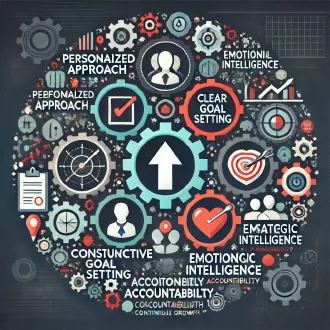Transcription Procedure for successful interaction at a meeting
In today's work environment, where productivity is vital, it is crucial to manage interactions effectively. Whether in formal meetings or informal discussions with individuals or groups, every interaction must serve a purpose. Conversation skills give you a distinct advantage in gaining support for your ideas and receiving positive feedback from others.
The key to meeting these practical needs is to employ a flexible and effective interaction procedure. An effective conversation guide is critical in this regard.
In describing a basic structure to guide any type of discussion, we encounter several stages. But what unites them is your willingness to listen empathetically and seek consensus or confirmation of mutual understanding at each step. Especially if it is a team meeting.
The introduction stage:
- In this first step, you set the mood and tone of the meeting so being positive and welcoming makes others feel comfortable sharing their ideas, opinions and challenges.
- The key thing at this stage is to introduce the topic of conversation and establish a clear purpose, explaining the "what" and "why" of the situation. Also, highlight how it would benefit the employees and the company to achieve that purpose.
- This stage also involves leaving room for possible related topics that may arise during the discussion. The topic can be brought up by the leader or another team member, but the what and why must still be established before moving forward.
The clarification stage:
- It delves into the details of the what and why defined in the first stage. It seeks to provide the facts, figures and information needed to fully understand the situation. This ensures that subsequent decisions are based on accurate information and avoids taking actions based on incomplete or incorrect data.
- At this stage, opinions and feelings come to the surface and it is important to provide as much detail as necessary to clarify doubts. Guide the conversation so that everyone has the opportunity to speak and contribute. Avoid letting one person dominate the discussion. Use open-ended questions to encourage dialogue and reflection. Questions such as "How do you feel about this?" or "What approach have you considered?" can generate meaningful conversations.
The exposure stage:
- The participation of all involved is encouraged. Opinions are heard, ideas are generated and solutions are evaluated. It is important that all participants provide their perspectives before the leader shares his or her opinion so that they do not feel intimidated. This equitable approach fosters greater creativity and commitment to the proposed solutions.
- The leader should make every effort to get everyone involved and also to find out what they think of the proposed solutions, as well as go about assessing the resources that will be needed to implement them.
The consent stage:
- This is essential to formalize the solutions and the steps to be taken. It specifies who will carry out what actions and in what timeframe. It also considers the resources needed to carry out these actions and obtains formal commitment from all parties.
- Make sure everyone understands their responsibilities. It is important to maintain a balance between the support provided by the leader and the responsibility assumed by each individual. It is also helpful to define some follow-up strategies.
The closing stage:
- The last step of this guide, involves reviewing the key points of the discussion and what was agreed upon. The understanding and commitment of each partici
interaction




